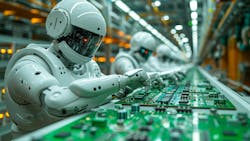If there is one technology that’s driving more excitement than artificial intelligence (AI) at the moment, it’s a particular application of AI—humanoid robots. In fact, many industry observers expect that one of the largest transitions in the global labor market is going to happen as a result of the development of a new generation of robots, specifically those in human form-factor. Goldman Sachs, for example, predicts the total addressable market for humanoid robots will reach $38 billion by 2035, with a substantial portion of this growth to come from the use of these robots use in structured environments like manufacturing.
Despite all the current excitement around humanoid robots, there remains a strong debate about the design of humanoids. One relates to their form factor while the other focuses on their current capabilities for human-like interaction.
The assumption that designing a robot in human form automatically enhances its functionality is not straightforward. But there are strong arguments for why it is a powerful form factor:
- Much of the world is built to fit the human form factor (homes, stores, factories), therefore, a robot operating in this world can only benefit from having a human-like form factor and mobility.
- Because humans thrive on interacting with people, the thesis is that, if a technology was designed to look like us, we would instinctively be able to interact with it more easily.
Why manufacturing is a key market for humanoids
Looking at the early markets for humanoid robots, the factory floor stands out as a prime candidate. This is for several reasons including the fact that factory floors are typically more structured environments (unlike other human-inhabited spaces). Additionally, tasks performed in these settings are often isolated, making it easier to train robots to perform specific tasks in a controlled, predictable environment.
The belief that the factory floor will be the first home for humanoid robotics is strongly supported by the number of trials now being conducted by humanoid robot manufacturers. For example, car companies including BMW, Mercedes and Tesla have announced plans for testing humanoid robots in their factories.
A key capability that remains underdeveloped with humanoid robots is human interactivity. This is a particular issue with respect to the use of a fluent conversational language for interacting with people.
The reason this issue is so important is that the most powerful use of a humanoid robot in a factory is going to be its ability to interact with people around it. This human-to-robot synergy will not only accelerate workflows but boost productivity through supporting humans in their work.
Perhaps the most significant challenge faced by humanoid robot manufacturers is that they typically come from a traditional robotics background. While building robots that can move and perform tasks is an incredible achievement, enabling them to speak, use non-verbal cues, perceive humans around them and interact with them in a meaningful way requires expertise across multiple fields. Disciplines such as linguistics, psychology, human-computer interaction, neuroscience and machine learning are all essential to the development of these interactive systems.
Unfortunately, these skills often remain isolated from the physical robotics aspect of development. Without this capability, humanoid robots—despite their human-like appearance—risk being relegated to environments where humans are likely not to be present, missing one of the fundamental reasons for which they are being designed today.
Samer Al Moubayed is CEO and founder of Furhat Robotics.
Read more about humanoid robots and their potential in manufacturing.
The video below highlights Furhat Robotics' approach to humanoid robots.


